FIRE RETARDANT ACM MATERIAL AND PANELS
Fire protection for your building begins at the planning stage. However, minimising fire risk – particularly in places with a heavy footfall and large crowds such as sporting arenas, mass transit terminals, hospitals, schools, and high-rise buildings – has become increasingly complex and challenging.
There days architects and building owners across the globe are required to meet stringent regulations aimed at protecting inhabitants and visitors as well as the building structure and surrounding environment from fire hazards. Whatever regulations are in place, it is incredibly important to choose the right grade of fire retardant materials to minimise the risk to life and damage to the building structure.
Using the right kind of products is key. We have taken the utmost care in choosing the right grade of Fire Retardant (FR) Aluminium Composite Materials (ACM) so as to mitigate the risk caused by fire.
It is important to understand the difference between Fire Rating and Fire Retardancy. Any product can have some degree of Fire Rating – but that does not necessarily make it Fire Retardant. Usually, products and systems have a certain reaction to fire and a resistance to fire. It is essential to look at both these aspects and the factors that influence the performance of a Fire Retardant cladding solution in totality, not in isolation.
The performance criteria are:
- Lateral and Vertical spread of fire
- Smoke emission
- Droplets
- Self-extinction of fire on the ACM
It is essential to choose the right product and system in terms of performance in case of fire – but it is equally important to specify the right test methodology and standards to ensure selection of a ‘true’ Fire Retardant panel.
Ideally, the right test methodology should be a combination of a product test like EN 13501-1 along with an intermediate-scale multi-story test like NFPA 285 or BS 8414, which addresses most of the key performance criteria mentioned above.
A true Fire Retardant ACM should have:
- Recommended mix and density of non- combustible content in the core (not less than 70%)
- Appropriate certifications from a credible third party authority (not sufficient to have mere test reports from samples provided by the applicant)
- Should be fixed using the recommended systems
FIRE BEHAVIOUR IN A BUILDING
The Illustration shows the fire propagation in case of fire in a building:
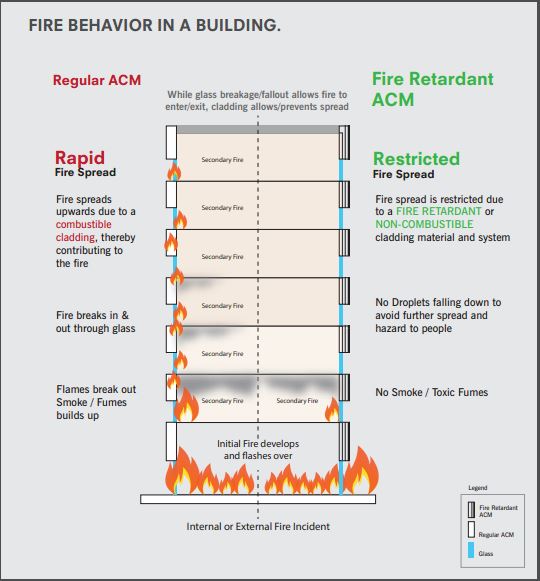
FIRE RETARDANCY VIDEO
ALUCOBOND PLUS FIRE CLASSIFICATION
| Country | Test accord. to … | Classification |
|---|---|---|
| Australia | AS ISO 9705 AS 1530.3 Indices EN 13501-1 | Group 1 material SMOGR A 1.385 m2 / s2 0 (ignitibility) 0 (flame spread) 0 (heat evolved) 0-1 (smoke development) B-s1, d0 |
| China | GB 8624-2012 | Class B1 (B- s1,d0, t0) |
| EU | EN 13501-1 | Class B-s1, d0 |
| Germany | EN 1187 (method 1) / DIN 4102-7 |
Passed |
| Great Britain England / Wales / Scotland |
BS 476, Part 6 & 7 BR 135 BS 8414 part 1 & 2 |
Class 0 met the performance criteria Passed |
| Malaysia | BS 8414-1 BS 476, Part 6 BS 476, Part 7 Approved for outdoor wall cladding of any type of building without height limit |
Passed Class 0 Class 1 |
| Poland | PN-90/B-02867 | NRO |
| Russia | GOST 30244-94 GOST 30402-95 GOST 12.1.044-89 GOST 12.1.044-89 |
G1 (combustibility) W1 (flammability) D1 (smoke development) T1 (toxicity) |
| Singapore | EN 13501-1 BS 476, Part 6&7 NFPA 285 Approved for outdoor wall cladding of any type of building without height limit |
Class B-s1, d0 Passed Passed |
| Switzerland | VKF | RF2 |
| UAE | NFPA 285 EN 13501-1 ASTM E84 |
Passed Class B-s1, d0 Class A |
| USA | ASTM E84 NFPA 285 |
Class A Passed |
ALUCOBOND A2 FIRE CLASSIFICATION
| Country | Test accord. to … | Classification |
|---|---|---|
| Australia | AS ISO 9705 AS 1530.3 Indices EN 13501-1 | Group 1 material SMOGR A 0.630 m2 / s2 0 (ignitibility) 0 (flame spread) 0 (heat evolved) 0-1 (smoke development) A2-s1, d0 |
| China | GB 8624-2012 | Class A (A2- s1,d0, t0) |
| EU | EN 13501-1 | Class A2-s1, d0 |
| Germany | EN 1187 (method 1) / DIN 4102-7 |
Passed |
| Great Britain England / Wales / Scotland |
BR 135 BS 8414 part 1 & 2 |
met the performance criteria Passed |
| Malaysia | BS 8414-1 BS 476, Part 6 BS 476, Part 7 Approved for outdoor wall cladding of any type of building without height limit |
Passed Class 0 Class 1 |
| Poland | EN 13501-1 | Class A2-s1, d0 |
| Russia | GOST 30244-94 GOST 30402-95 GOST 12.1.044-89 GOST 12.1.044-89 |
G1 (combustibility) W1 (flammability) D1 (smoke development) T1 (toxicity) |
| Singapore | EN 13501-1 BS 476, Part 6&7 (Core Exposed) NFPA 285 Approved for outdoor wall cladding of any type of building without height limit |
Class A2, s1, d0 Passed Passed |
| Switzerland | VKF | RF1 |
| UAE | NFPA 285 EN 13501-1 ASTM E84 |
Passed Class A2-s1, d0 Class A |
FIRE RETARDANCY NEWSLETTER

ALUCOBOND® and Fire Retardancy
Keep up to date with the latest news and industry developments regarding Fire Retardancy and Safety with our newsletter. Staying abreast of current regulations and developments is essential for working successfully on new construction and design projects.
FIRE RETARDANCY PRESENTATION

FIRE RETARDANCY BROCHURE

ALUCOBOND® Fire Retardancy
Due to stricter global regulations and the evermore demanding requirements of modern architecture, choosing the right fire retardancy products and systems is essential. Download our in-depth brochure to find out how ALUCOBOND* meets these challenges through experience and innovation to lead the market.
MINERAL CALCULATOR
Download our Mineral Calculator by clicking the link below.
Download Mineral Calculator for Desktop
COMMONLY REQUESTED FIRE TESTS
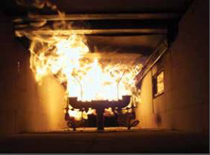
ASTM E-84
This test measures the distance of the flame spread and the light obscuration of the smoke development during a specific time period.
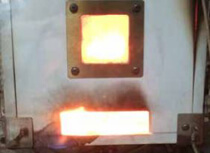
BS 476 – Part 6&7
This test measures the speed and the distance of the flame spread in a specific time period.
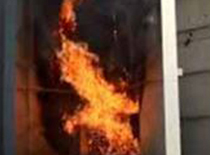
BS 8414-1
This test assesses the behaviour of a non-load bearing external cladding system. The test measures fire spread and classifies based on three distinct ways: external fire spread, internal fire spread, and mechanical performances.
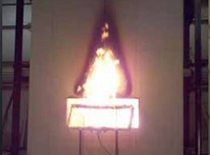
NFPA 285
This test method evaluates the inclusion of combustible components within wall assemblies/panels that are required to be of non-combustible construction. It is a simulation of the multi-storey flammability fire performance of entire exterior wall assemblies.
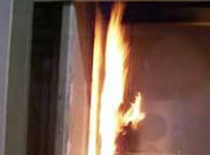
EN 13501-1
This test measures the spread of flame and contribution to fire, as well the generation of smoke and the production of burning droplets.




